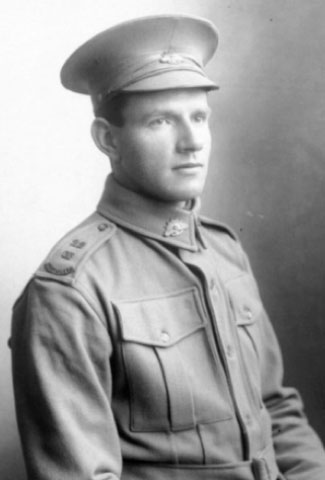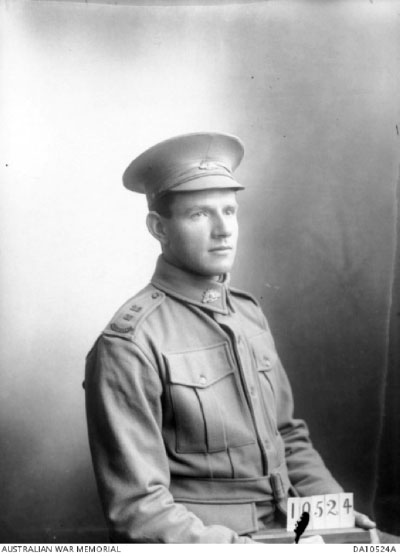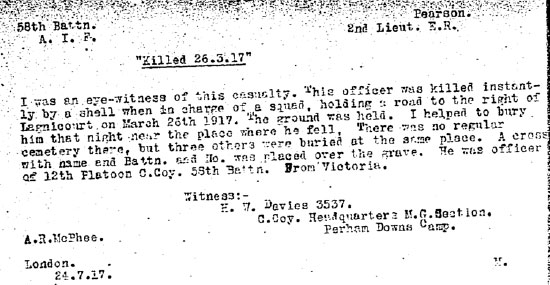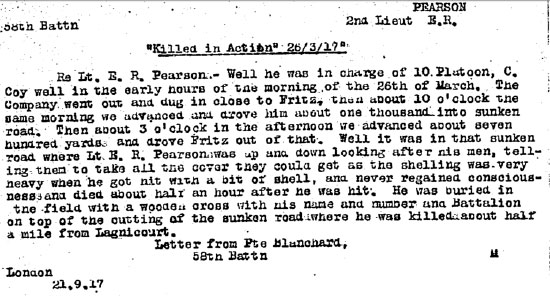War Memorial Hall c1929

Ebenezer Ralph PEARSON

Ralph Pearson was born on 27 October 1888 in Benalla, Victoria. His parents were Frederick Thomas Birks and Catherine (née Madden) Pearson. He attended Scotch from 1902 to 1904.
Ralph was a commercial traveller when he enlisted on 19 June 1915 in Melbourne. He served in the 8th Battalion, the 15th Machine Gun Company, and the 58th Battalion with the final rank of 2nd Lieutenant. His Regimental Number was 2738.
Ralph died on 26 March 1917 at Lagnicourt, France. He was 28 years of age.
Service record
Ralph ‘E.R.’ Pearson was initially allotted to reinforcements for the 22nd Battalion and then to the 8th Battalion. After leaving Australia in September 1915 he served at Gallipoli with the 8th from 7 December. He was transferred to the newly formed 60th Battalion in Egypt in February 1916. The following month he joined the 15th Brigade Machine Gun Company. He went to a School of Instruction at Zeitoun, Egypt, in April 1916. He reached Marseille, France, with that unit in June 1916, and in November-December attended another School of Instruction. He had some leave in England in January-February 1917 and on his return on 12 February 1917 joined the 58th Battalion as a 2nd Lieutenant. Presumably this was a happy beginning to the new year, but he would not survive March.
His service record contains a file in which an unknown officer said that Ralph ‘was Killed in Action during an attack at Morchies near Bapaume on 26.3.17. No wounds were on his body, death having been caused by shell concussion.’ This detail was only transmitted to his mother in October 1919. In February 1918 a soldier had contacted the Australian Red Cross on her behalf, as she had never received any details of his death. Consequently, a quite extensive Red Cross Wounded and Missing file was created.
An eyewitness to his death, Harold Davies, said that Pearson was ‘killed instantly by a shell’ while leading a squad in holding a Sunken Road near Lagnicourt (see below). Davies, a pre-war schoolteacher who would win the Military Medal and be killed in 1918, helped to bury Ralph. Private Evan Thomas said in his report that Pearson was his Platoon commander, leading 10 Platoon of C Company. He reported that Pearson ‘was killed in a rough dug-out at right of Lagnicourt’. The men had just dug themselves in after advancing. Pearson’s body ‘was not much injured’. His batman, Private Charles Blanchard, helped to bury Pearson. He later wrote an account of the night in which he explained that Pearson had been looking after his men, making sure they kept their heads down, when he himself was hit (see below).
Another eyewitness claimed that Pearson was hit in the back by shrapnel and also saw his grave nearby with a board above. That grave was later lost and no one knows where Ralph Pearson is buried. Several accounts mention that Ralph died near a sunken road. So did fellow Scotchie James Stewart, who was killed on the same day. Neither man has an identifiable grave.
Ralph Pearson is commemorated at the Australian National Memorial, Villers-Bretonneux, France.
Photographs and Documents:

A studio portrait of Ralph Pearson taken at Broadmeadows in about September 1915

Harold Davies’ eyewitness report of Ralph Pearson’s death, from his Red Cross Wounded and Missing file.

Account of Lt Pearson’s death, by his batman, Private Charles Blanchard.
Sources:
- Australian War Memorial – Roll of Honour and Red Cross Wounded and Missing file
- Mishura Scotch Database
- National Archives of Australia – B2455, PEARSON EBENEZER RALPH
- Scotch Collegian 1921
- The AIF Project - https://www.aif.adfa.edu.au/showPerson?pid=237151


